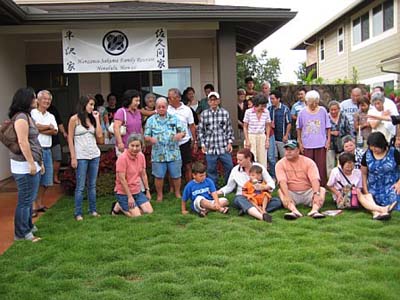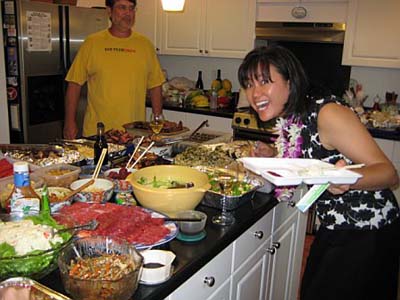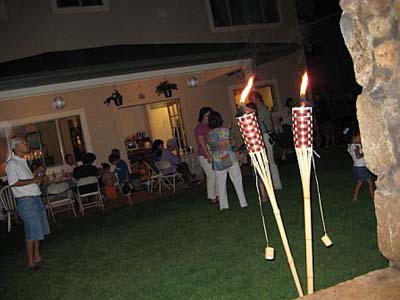18 Sep Hawaiian Eye – Pt. 2 (The Pre-Party)
 |
Sunday, September 16, 2007
Yesterday was a long day, and a preview of today’s reunion.
We started with the relaxed morning of papaya and conversation with Laura, but eventually moved on to the day’s work: shopping at Costco and then the Star Market for the ingredients to make our “kakimochi” chips for the party. The chips are a favorite of our friends in Colorado – they’re Mexican corn tortillas coated with a JA combination of sugar, butter and soy sauce – and although we figured Hawaiians surely must have this kind of cross-cultural snack all the time, it’s relatively easy to make and tasty and we decided to offer to make it for the party anyway.
Costco was a revelation. I’d been there, several years ago when I attended the JACL National Convention in Honolulu. But it seemed like they’d expanded their aisle of local goods, and throughout the store was an amazing array of Asian foods and products, from imported Japanese canned tea to spices. The local aisle had a dizzying selection of all things macadamia, as well as shelf after shelf of snack items like picked plums, li hing-flavored mangoes, dried shredded ika (cuttlefish) and dried octopus and squid, both in large jars or individually wrapped. Yummy… these are Asian equivalents of beer nuts at the bar. We wished we could get some of these more “exotic” items in Colorado Costcos, and also marveled that the Hawaiian population, which isn’t all Asian by any means (although certainly “haoles,” or Caucasians, are in the minority between all the Asian as well as Polynesian ethnicities), all buys this variety of products. Multiculturalism is simply in the air in Hawaii, like the humidity… and the wind.
The Star Market, a local equivalent of a Safeway, King Sooper or Albertsons, was similar in that it had a lot more Japanese and Asian products throughout the store, and not just in the “Oriental” aisle. It was cool seeing a whole shelf of different flavors of furikake, a mix of seaweed and spices you sprinkle over rice, on display.
When we got back to Laura and John’s house Erin began baking the chips for the party while I helped John set up outside. We planted tiki torches around the perimeter of the yard, and set up the grill and folding chairs and tables.
 There was enough food at the pre-reunion party to cover this counter top, which is the size of a double bed. |
At 4 pm the first guests arrived (very Japanese to be so damned prompt), and then the next few hours were a blur. There were about 50 guests, and Erin and I couldn’t keep the relatives’ names straight after a while.
Each brought some food, and some people seemed to misunderstand the invite – instead of bringing meat for the grill for themselves, they brought enough meat for everyone. People were theowing down packages of 8 pounds of steaks. The variety was incredible. As usual, Erin and I celebrate life through food, and we were in heaven, with so many dishes. There was Korean calbi (marinated BBQ ribs), bulgogi (thin-sliced Korean marinated beef) a family recipe for miso chicken, marinated chicken, rice with edamame and mushrooms, fried rice, several noodle dishes, steaks, sushi, a handful of desserts (including a wonderful haupia cake), and a lot more. A LOT more. A WHOLE LOT more….
We were introduced to a flurry of relatives – way too many to keep track – and heard all night long the playful lilt of the Hawaiian accent. It’s a sound I know in subtle form from hearing my dad’s speech change every time he spoke to someone from Hawaii. Even though he only lived there as a kid, he picked up enough inflection that it would come out at times.
Words are truncated (“Japanee” instead of “Japanese”) and other words added to the end of sentences with an upward tilt of a query (“So I go to the store today, you know?”). At its strongest, English words are mutated into pidgin, until “brother” sounds like “bruddah” or even “bra.”
It’s easy to pick up mannerism, and begin talking a bit like a Hawaiian, yah?
Japanese Hawaiians are as susceptible as anyone else in Hawaii to the island accent, and everyone who lives here a long time seems to speak with varying degrees of the wonderful local inflection. It’s wild hearing people speak a mix of English and Japanese, with the English part strongly accented.
Oh, and one more thing about Hawaii – although Caucasians are a minority population, and there’s a very strong presence of native culture (most place and street names, for instance, have native names like Mililani or Ka Oku Blvd., with the odd name like “Admiral Nimitz Highway” the exception).
 It wouldn’t be a party in Hawaii without tiki torches…. It wouldn’t be a party in Hawaii without tiki torches…. |
The guests stayed pretty late, and everyone took home “nokori,” or leftovers, thoughtfully packed in styrofoam boxes by some family members in the kitchen while the party raged out in the backyard.
At the end of he evening, we left John and his younger daughter Marika watching a re-broadcast of the U. of Hawaii football game against UNLV (they trounced Las Vegas) from earlier in the evening in one room and Laura and her oldest daughter Jenny in another, sweating over the slide show of family photos to play during the reunion on Sunday.
Later we found out Jenny stayed until 3 am, and Laura and John cleaned up and called it a night at 3:30.
The JA-style chips were a big hit, by the way, and it turns out they were novel even in cross-cultural Hawaii.




